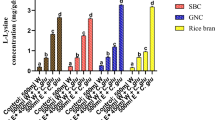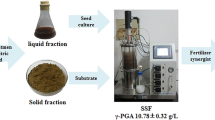Abstract
An economical source of nitrogen is one of the major limiting factors for sustainable cadaverine production. The utilization potential of soybean residue for enhanced cadaverine production by engineered Escherichia coli DFC1001 was investigated in this study. The SRH from soybean residue could get the protein extraction rate (PE) of 67.51% and the degree of protein hydrolysis (DH) of 22.49%. The protein molecular weights in SRH were mainly distributed in 565 Da (72.28%) and 1252 Da (17.11%). These proteins with small molecular weights and concentrated molecular weight distribution were favorable to be transformed by engineered E. coli DFC1001, and then SRH replaced completely yeast powder as an only nitrogen source for cadaverine production. The maximum cadaverine productivity was 0.52 g/L/h, achieved with a constant speed feeding strategy in the optimized SRH fermentation medium containing an initial total sugar concentration of 30 g/L and exogenous added minerals, which indicated that soybean residue could be a potential feedstock for economic cadaverine production.






Similar content being viewed by others
References
Kim, H. T., Baritugo, K. A., Oh, Y. H., Hyun, S. M., Khang, T. U., Kang, K. H., Jung, S. H., Song, B. K., Park, K., Kim, I. K., Lee, M. O., Kam, Y., Hwang, Y. T., Park, S. J., & Joe, J. C. (2018). Metabolic engineering of Corynebacterium glutamicum for the high-level production of cadaverine that can be used for the synthesis of biopolyamide 510. ACS Sustainable Chemistry & Engineering, 6(4), 5296–5305.
Qian, Z. G., Xia, X. X., & Lee, S. Y. (2011). Metabolic engineering of Escherichia coli for the production of cadaverine: a five carbon diamine. Biotechnology and Bioengineering, 108(1), 93–103.
Kind, S., Neubauer, S., Becker, J., Yamamoto, M., Volkert, M., von Abendroth, G., Zelder, O., & Wittmann, C. (2014). From zero to hero - production of bio-based nylon from renewable resources using engineered Corynebacterium glutamicum. Metabolic Engineering, 25, 113–123.
Schneider, J., Niermann, K., & Wendisch, V. F. (2011). Production of the amino acids L-glutamate, L-lysine, L-ornithine and L-arginine from arabinose by recombinant Corynebacterium glutamicum. Journal of Biotechnology, 154(2-3), 191–198.
Kwak, D. H., Lim, H. G., Yang, J., Seo, S. W., & Jung, G. Y. (2017). Synthetic redesign of Escherichia coli for cadaverine production from galactose. Biotechnology for Biofuels, 10(1), 20.
Ma, W. C., Chen, K. Q., Li, Y., Hao, N., Wang, X., & Ouyang, P. K. (2017). Advances in cadaverine bacterial production and its applications. Engineering, 3(3), 308–317.
Buschke, N., Schroder, H., & Wittmann, C. (2011). Metabolic engineering of Corynebacterium glutamicum for production of 1,5-diaminopentane from hemicellulose. Biotechnology Journal, 6(3), 306–317.
Dhar, K. S., Wendisch, V. F., & Nampoothiri, K. M. (2016). Engineering of Corynebacterium glutamicum for xylitol production from lignocellulosic pentose sugars. Journal of Biotechnology, 230, 63–71.
Alvarado-Cuevas, Z. D., Acevedo, L. G. O., Salas, J. T. O., & De Leon-Rodriguez, A. (2013). Nitrogen sources impact hydrogen production by Escherichia coli using cheese whey as substrate. New Biotechnology, 30(6), 585–590.
Zhou, X. P., Wang, F., Hu, H. W., Yang, L., Guo, P. H., & Xiao, B. (2011). Assessment of sustainable biomass resource for energy use in China. Biomass & Bioenergy, 35(1), 1–11.
Nguyen, T. H., Ra, C. H., Sunwoo, I. Y., Sukwong, P., Jeong, G. T., & Kim, S. K. (2018). Bioethanol production from soybean residue via separate hydrolysis and fermentation. Applied Biochemistry and Biotechnology, 184(2), 513–523.
Vong, W. C., & Liu, S. Q. (2016). Biovalorisation of okara (soybean residue) for food and nutrition. Trends in Food Science & Technology, 52, 139–147.
Loman, A. A., Islam, S. M. M., & Ju, L. K. (2018). Production of arabitol from enzymatic hydrolysate of soybean flour by Debaryomyces hansenii fermentation. Applied Microbiology and Biotechnology, 102(2), 641–653.
Jiang, K., Tang, B., Wang, Q., Xu, Z. Q., Sun, L., Ma, J. J., Li, S., Xu, H., & Lei, P. (2019). The bio-processing of soybean dregs by solid state fermentation using a poly gamma-glutamic acid producing strain and its effect as feed additive. Bioresource Technology, 291, 121841.
Huang, X. D., Zhao, J. W., Xu, Q. X., Li, X. M., Wang, D. B., Yang, Q., Liu, Y., & Tao, Z. L. T. (2019). Enhanced volatile fatty acids production from waste activated sludge anaerobic fermentation by adding tofu residue. Bioresource Technology, 274, 430–438.
Yoshii, H., Furuta, T., Maeda, H., & Mori, H. (1996). Hydrolysis kinetics of okara and characterization of its water-soluble polysaccharides. Bioscience, Biotechnology, and Biochemistry, 60(9), 1406–1409.
Li, S. H., Gao, A., Dong, S., Chen, Y., Sun, S., Lei, Z. F., & Zhang, Z. Y. (2017). Purification, antitumor and immunomodulatory activity of polysaccharides from soybean residue fermented with Morchella esculenta. International Journal of Biological Macromolecules, 96, 26–34.
Florencio, C., Badino, A. C., & Farinas, C. S. (2016). Soybean protein as a cost-effective lignin-blocking additive for the saccharification of sugarcane bagasse. Bioresource Technology, 221, 172–180.
He, X., Chen, K. Q., Li, Y., Wang, Z., Zhang, H., Qian, J., & Ouyang, P. K. (2015). Enhanced L-lysine production from pretreated beet molasses by engineered Escherichia coli in fed-batch fermentation. Bioprocess and Biosystems Engineering, 38(8), 1615–1622.
Thakker, C., San, K. Y., & Bennett, G. N. (2013). Production of succinic acid by engineered E. coli strains using soybean carbohydrates as feedstock under aerobic fermentation conditions. Bioresource Technology, 130, 398–405.
Ying, H. X., He, X., Li, Y., Chen, K. Q., & Ouyang, P. K. (2014). Optimization of culture conditions for enhanced lysine production using engineered. Bioscience Biotechnology and Biochemistry, 60, 1406–1409.
Campos, V. M., Silva, F. L. F., Oliveira, J. P. S., Ribeiro, L. P. D., Matos, W. O., & Lopes, G. S. (2019). Investigation of a rapid infrared heating assisted mineralization of soybean matrices for trace element analysis. Food Chemistry, 280, 96–102.
He, X., Miao, Y. L., Jiang, X. J., Xu, Z. D., & Ouyang, P. K. (2010). Enhancing the enzymatic hydrolysis of corn stover by an integrated wet-milling and alkali pretreatment. Applied Biochemistry and Biotechnology, 160(8), 2449–2457.
Adler-Nissen, J. (1986). Enzymic hydrolysis of food proteins. London: Elsevier Applied Science Publishers.
Chen, C. C., Lee, T. T., Bin Hsu, C., Huang, C. W., & Yu, B. (2011). Associations of allergenic soybean proteins with piglet skin allergic reaction and application of polyclonal antibodies. Animal Production Science, 51(11), 1008–1014.
Nyo, M. K., & Nguyen, L. T. (2019). Value-addition of defatted peanut cake by proteolysis: effects of proteases and degree of hydrolysis on functional properties and antioxidant capacity of peptides. Waste and Biomass Valorization, 10(5), 1251–1259.
Gomez, A. O., Rubio, J. P., Moral, M. T., Morgado, B. R., & Jimenez, P. C. (2017). Okara valorization process by fermentation with Bacillus licheniformis: obtention of hydrolytic enzymes, bioactive compounds, and protein hydrolysates. Journal of Biotechnology, 256, S62–S63.
Zhao, H. F., Wan, C. Y., Zhao, M. M., Lei, H. J., & Mo, F. (2014). Effects of soy protein hydrolysates on the growth and fermentation performances of brewer’s yeast. International Journal of Food Science and Technology, 49(9), 2015–2022.
Ekwealor, I. A., & Obeta, J. A. N. (2007). Effect of vitamins and bivalent metals on lysine yield in Bacillus megaterium. African Journal of Biotechnology, 6, 1348–1351.
Brand, E., Junne, S., & Neubauer, P. (2010). Divalent ion composition and demand for E. coli in high cell density cultivations. Journal of Biotechnology, 150, S402–SS02.
Bizukojc, M., Pawlowska, B., & Ledakowicz, S. (2007). Supplementation of the cultivation media with B-group vitamins enhances lovastatin biosynthesis by Aspergillus terreus. Journal of Biotechnology, 127(2), 258–268.
Funding
This work was supported by Jiangsu postdoctoral research support program (Grant Nos. 2019K242), the National Nature Science Foundation of China (Grant Nos. 21576134), the National Key Research and Development Program of China (2016YFA0204300).
Author information
Authors and Affiliations
Corresponding author
Ethics declarations
Conflict of Interest
The authors declare that they have no conflict of interest.
Additional information
Publisher’s Note
Springer Nature remains neutral with regard to jurisdictional claims in published maps and institutional affiliations.
Rights and permissions
About this article
Cite this article
Guo, X., Li, M., Li, H. et al. Enhanced Cadaverine Production by Engineered Escherichia coli Using Soybean Residue Hydrolysate (SRH) as a Sole Nitrogen Source. Appl Biochem Biotechnol 193, 533–543 (2021). https://doi.org/10.1007/s12010-020-03444-1
Received:
Accepted:
Published:
Issue Date:
DOI: https://doi.org/10.1007/s12010-020-03444-1




